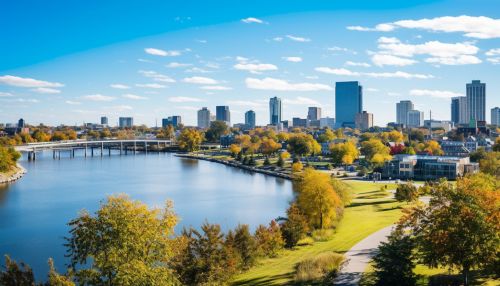Wilmington, Delaware
History
Wilmington, the largest city in the state of Delaware, has a rich and diverse history that dates back to the 1600s. Originally inhabited by the Lenape people, the area was first colonized by Swedish settlers in 1638, who named it Fort Christina. The city's strategic location on the Delaware River made it a valuable asset, leading to its eventual acquisition by the English in 1664.


In the 18th century, Wilmington began to develop as an industrial hub. The city's growth was largely driven by the DuPont Company, a chemical manufacturing firm established in 1802 by Éleuthère Irénée du Pont. The company played a significant role in the city's economic development, producing gunpowder and later diversifying into chemicals and materials science.
During the American Civil War, Wilmington was a major center for the manufacture of war materials. The city's shipbuilding industry also thrived during this period, with the Harlan and Hollingsworth company becoming a leading producer of iron steamships.
In the 20th century, Wilmington continued to grow and diversify, with the establishment of new industries such as automobile manufacturing and financial services. Today, the city is home to a number of Fortune 500 companies, including Chemours and Navient, and is a major center for the credit card industry.
Geography
Wilmington is located in the northern part of Delaware, at the confluence of the Delaware River and the Christina River. The city's topography is characterized by rolling hills and valleys, with the highest point being located in the northwest part of the city.
The city's climate is classified as a humid subtropical climate, with hot, humid summers and mild to cool winters. Wilmington experiences four distinct seasons, with precipitation evenly distributed throughout the year.
Economy
Wilmington's economy is diverse and robust, with key sectors including finance, healthcare, education, and manufacturing. The city is known as the corporate capital of the world, due to its business-friendly laws and the presence of numerous corporations.
The financial sector is particularly significant, with many major banks and credit card companies having operations in the city. Wilmington is also home to a thriving healthcare sector, with institutions such as the Christiana Care Health System and the Nemours Alfred I. duPont Hospital for Children providing employment and contributing to the local economy.
Culture
Wilmington boasts a vibrant cultural scene, with numerous museums, galleries, and performance venues. The city's cultural institutions include the Delaware Art Museum, the Delaware Theatre Company, and the Grand Opera House.
The city also hosts several annual events and festivals, such as the Wilmington Flower Market and the Delaware Shakespeare Festival, which attract visitors from around the region and beyond.
Education
Wilmington is served by several school districts, including the Red Clay Consolidated School District and the Christina School District. The city is also home to a number of private and charter schools.
Higher education institutions in Wilmington include the University of Delaware, Wilmington University, and the Delaware College of Art and Design.
Transportation
Wilmington is well-connected by various modes of transportation. The city is served by the Wilmington Station, which provides Amtrak and SEPTA services. The Wilmington Airport offers commercial flights, while the Port of Wilmington is a major hub for cargo and shipping.
